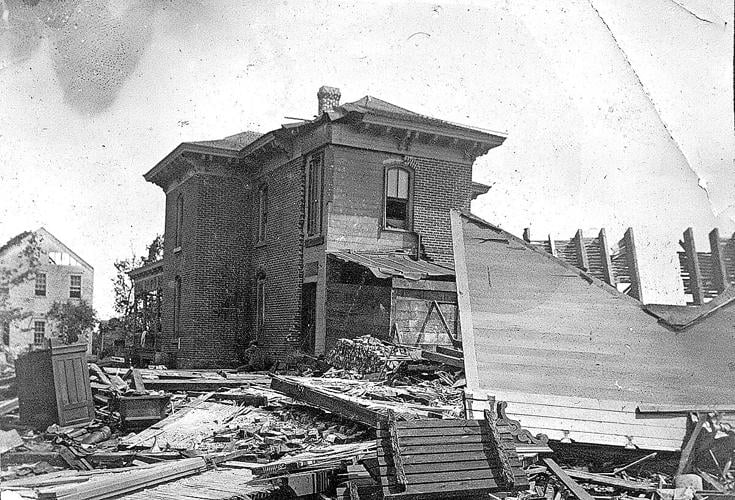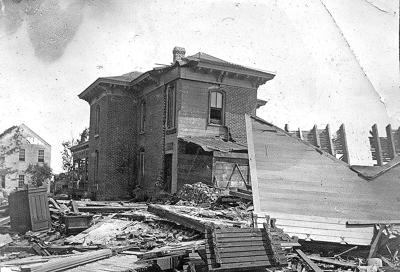In June of 1899, one of the 10 deadliest tornadoes in U.S. history hit the town of New Richmond, Wis., killing 117 people, turning infrastructure into rubble in its wake. Mike Augustyniak, who works for the present-day WCCO as a meteorologist, was asked to do a talk about that natural disaster in 2024.
Augustyniak admitted he didn’t know much about the New Richmond “Cyclone” — in quotes because today it’s considered to be a tornado — until Todd Kittel, an adjunct instructor at Northwood Technical College, reached out.
Kittel, also an Information & Reference Assistant for the New Richmond Public Library, wanted Augustyniak to help him with the presentation at his college on June 12 to mark the 125th anniversary.
So Augustyniak learned about it and showed up to Northwood Technical College for the talk — to find a packed room and a pretty full annex waiting to hear his thoughts.
“I give all the credit to New Richmond still being a close-knit community, and people not caring about just their present, but their past,” Augustyniak said. “I think, in part, because everybody does at least know of the story of the storm that lives in that area, and maybe even has a family member or friend of the family that has some direct impacts, going back all those years.”
A media circus
During the presentation, Kittel showed examples of the ensuing media storm that occurred after the tornado hit the town.
Various news outlets at the time were fascinated by the natural disaster. An Australian newspaper, referring to the state as “Winsconsin,” reported that women pulled their hair and screamed that the end of the world had come — which was later deemed an inaccurate account. They also said that residents were not able to reach their “caves.”
“I didn’t know that Aussies pronounced ‘basements’ [as] ‘caves.’” Kittel said during the presentation.
The Minneapolis Tribune reported that the circus in town caused animals to run loose; while, in reality, the circus was pretty much unscathed, because it was so far away from the tornado.
As mentioned previously, there’s even been a revisionist history of calling the disaster a cyclone, the original designation at the time that doesn’t represent the modern definition of a cyclone today. By today's definitions, cyclones are typically longer lived weather systems than tornadoes and can form on waters of at least 26 degrees.
"I think there was some some pressure to not use the term tornado that may be partially also recycled," Augustyniak said. Later, he added: "It certainly looks like it was a high-end tornado."
Eye for the storm
Judith Hackbarth once owned and operated the Old Gem Theater, working with the Stagedoor Players in New Richmond.
There, she often worked with local kids to put on productions, even writing her own historically accurate play about the New Richmond Cyclone. While working on the play, Hackbarth said she learned a lot about the natural disaster that tore apart New Richmond. Among other things, she also taught middle school language arts in the town.
Recently, she combined her skill sets of language arts and New Richmond history to write “The Night of the Circus Cyclone,” a self-published book now on Amazon that weaves a fictitious narrative around the disaster. Though unlike the journalism of the time, this telling is transparently fiction: Hackbarth changed the names and added a storyline, while keeping some of the historical essence intact.

She teamed up with one of her granddaughters, Katie Harris, to produce the book’s cover and pages, then Harris helped publish it online. Harris studies graphic design, animation and illustration at Northwestern in St. Paul, Minn. Hackbarth is glad that worked out.
“There's no way my generation could do it without a granddaughter. I could never have figured it out,” Hackbarth said. “I can't even figure out that Amazon program.”
Harris just finished up her freshman year, and said she’s already learned a lot, which makes her a bit embarrassed by the book she finished before some of that learning.
Recently, she made cover art for her friends’ band “The Pine Neadles.” She enjoys graphic design, and studies animation to keep her design options open. After adjusting the pages for Hackberth’s book, though, she is pretty confident she will not be choosing that as a career choice.
“I don't know about books, but I would definitely do a cover again. I think formatting is not for me,” Harris said.
For the cover, they had some ideas. Ultimately, the duo settled on a dark, storm-like background with a circus and various circus supplies soaring through the air — encapsulating the storm and the pandemonium it caused.
With the cover done and tweaks made to the copy inside the book, it became one of the many retellings of New Richmond's historic storm.
“We changed it to just that cyclone as being the main thing there,” Harris said.
You can get the book here.





(0) comments
Welcome to the discussion.
Log In
Thank you for taking part in our commenting section. We want this platform to be a safe and inclusive community where you can freely share ideas and opinions. Comments that are racist, hateful, sexist or attack others won’t be allowed. Just keep it clean. Do these things or you could be banned:
• Don’t name-call and attack other commenters. If you’d be in hot water for saying it in public, then don’t say it here.
• Don’t spam us.
• Don’t attack our journalists.
Let’s make this a platform that is educational, enjoyable and insightful.
Email questions to [email protected].